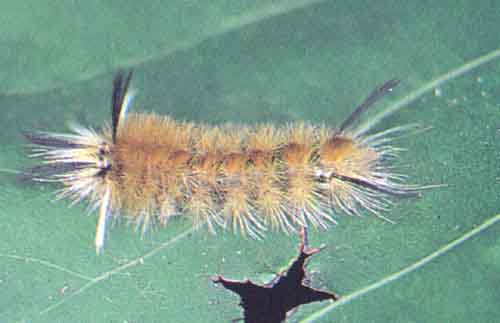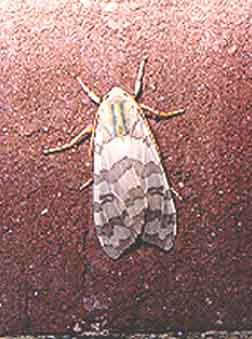The Pale Tussock Moth:
Halysidota tesselaris

Pale Tussock Moth Caterpillar: Halysidota tesselaris
This site has been created by
Bill Oehlke at oehlkew@islandtelecom.com
Comments, suggestions and/or additional information are welcomed by Bill.
New!
Caring for Woolly Bear CaterpillarsPale Tussock Moth caterpillars are often found in the fall when their larger size and
bright colouration draw attention. Halysidota tesselaris caterpillars are covered with a dull
grey, tan or yellow-brown coloured hair and have long paired black and white lashes emanating from the second and third thoracic
segments, and a third set projecting from the eighth abdominal segment.
Cocoons, spun up in the fall, often incorporate some of the body hairs.
Tesselaris Tiger Moths emerge from cocoons the following spring. The underwings are a plain,
pale yellow and the moths generally resemble the image of Lophocampa maculata (below), but
colouration is much paler. Wings almost look like they are coated with thin wax layer rather
than normal moth wing scales.
The Pale Tussock Moth, (Halysidota tesselaris, wingspan 3.0 - 5.0 cm) ranges across the eastern half of Canada,
the U.S. and Mexico.
Halysidota tesselaris caterpillars motor quite rapidly and feed on a variety of food plants
including most forest trees.
There is but a single generation each year with moths eclosing in the spring.
After nightfall, the female moth extends a scent
gland from the tip of her abdomen.
Night-flying males zigzag in their flights into the wind, pick up the airbourne scent with their
antennae, and locate and mate with the calling female.
Upon separating, the male looks for another mate while the female begins her ovipositing flight
under cover of darkness. Eggs are widely dispersed on a variety of hosts.
Male Halysidota tesselaris moths come in to lights and rest with wings folded over their backs.
If this info has been helpful, please click on the flashing butterfly to express appreciation and to visit other related sites. |
 |
or go to Introduction to WORLD'S LARGEST SATURNIIDAE SITE and click on flashing butterfly there. This site features spectacular photography with the most extensive set of Saturniidae files found anywhere on the internet.
Woolly bear or fuzzy bear caterpillars come in a variety of colours and patterns, many of them
quite striking!
Click on the hypertext (blue print) below to access info and images of various Tiger Moth adults
and caterpillars:
ARCTIIDAE (TIGER MOTH) INDEX:
Larval images are from Caterpillars of Eastern Forests courtesy of David Wagner.
Visit other websites maintained by Bill Oehlke:
Have a nice day!
Go to
Caterpillar Identification









